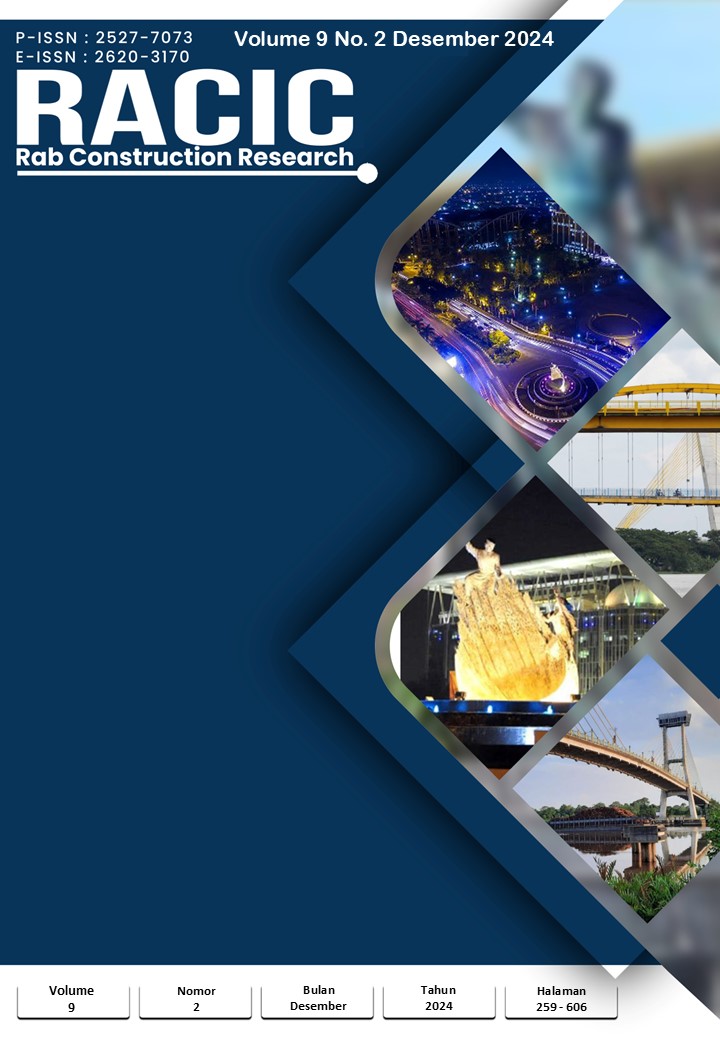ENGINEERING PROPERTIES TANAH LEMPUNG DENGAN SEMEN SEBAGAI SOIL IMPROVEMENT
DOI:
https://doi.org/10.36341/racic.v9i2.4951Keywords:
Stabilisasi Tanah, CBR, Indeks PlastisitasAbstract
Volume instability in expansive soils due to changes in moisture content results in damage to the supporting structure. Soil improvement is one of the efforts made for soil improvement. Soil stabilization is one part of soil improvement. Appropriate soil improvement needs to be carried out to see the performance of the soil to meet post-construction stability requirements. Chemical stabilization using cementitious soil materials can improve the engineering properties of expansive soils. The research objective is to analyze the value of engineering properties of expansive soil with cement. Experimental research method to determine the value of California Bearing Ratio (CBR and Atterberg limits. Expansive soil was stabilized with cement with variations of 10, 12, and 14% cement by weight. As a result, the value of engineering properties increased, namely the maximum CBR value of 7.40% in the 14% variation at a curing time of 7 days. The smallest PI value in the 14% cement variation is 13.65%, there is a decrease in PI value with the addition of cement. In conclusion, engineering properties of soil with cement stabilization increase the CBR value of soil and decrease the Plasticity Index value.
Downloads
References
D. Barman and S. K. Dash, “Stabilization of Expansive Soils Using Chemical Additives: A review,†J. Rock Mech. Geotech. Eng., vol. 14, no. 4, pp. 1319–1342, 2022, doi: https://doi.org/10.1016/j.jrmge.2022.02.011.
A. Sorsa, “Engineering Properties of Cement Stabilized Expansive Clay Soil,†Civ. Environ. Eng., vol. 18, no. 1, pp. 332–339, 2022.
Pratikso, A. Rochim, R. Mudiyono, and A. Situmorang, “Stabilization of Expansive Soil with Lime, Fly Ash and Cement,†Int. J. Intell. Syst. Appl. Eng., vol. 11, no. 4s, pp. 491–497, 2023.
F. N. W, E. A. S, Y. Zaika, A. Munawir, and A. Rachmansyah, “Perbaikan Tanah Ekspansif Dengan Penambahan Serbuk Gypsum dan Abu Sekam Padi Untuk Mengurangi Kerusakan Struktur Perkerasan,†Rekayasa Sipil, vol. 9, no. 3, pp. 1–6, 2015.
Mawardi, M. R. Razali, and O. Wijaya, “Nilai CBR Pada Stabilisasi Tanah Dengan Semen Jalan Budi Utomo Unib Depan,†J. Inersia, vol. 8, no. 2, p. 67, 2016.
L. Sun, H. Zhao, H. Tu, and Y. Tian, “The Smart Road: Practice and Concept,†Engineering, vol. 4, no. 4, pp. 436–437, 2018.
H. Hariyanto and S. Jatmiko, “Pengaruh Penggunaan Semen Sebagai Bahan Stabilisasi Tanah Lempung Lunak Di Daerah Grobogan Purwodadi,†J. Ilm. Teknosains, vol. 7, no. 1/Mei, pp. 44–51, 2021.
P. Takaendengan, M. S, J. . Ticoh, and SumampouwJ.R, “Pengaruh Stabilisasi Semen Terhadap Swelling Lempung Ekspnasif,†J. Sipil Statik, vol. 1, no. 6, pp. 382–289, 2013.
E. Elendra and A. Prihatiningsih, “Analisis Tanah Ekspansif Dengan Perbaikan Semen Putih Dan Semen Hitam Menggunakan UCT,†JMTS J. Mitra Tek. Sipil, vol. 2, no. 3, p. 53, 2019.
N. S. Surjandari, N. Djarwanti, Y. M. Purwana, B. Setiawan, B. B. Prakosa, and S. N. Fitri, “Potensi Kembang Susut Tanah Ekspansif di Wilayah Solo Raya (Studi Kasus di Trucuk, Pedan, dan Nogosari),†Matriks Tek. Sipil, vol. 9, no. 4, p. 283, 2021.
M. Anggraini, V. T. Haris, and A. Saleh, “Stabilisasi Tanah Lempung Dengan Abu Tandan Sawit dan Semen Terhadap Tingkat Kepadatan Tanah,†J. RACIC, vol. 7, no. 1, pp. 44–54, 2022, [Online]. Available: https://scholar.archive.org/work/324a7gurbrcsfcdect7odt2mzq/access/wayback/http://jurnal.univrab.ac.id/index.php/racic/article/download/1423/897.
Y. Amran and D. Kurniawan, “Perencanaan Dinding Penahan Tanah Sungai Way Batanghari Kota Metro Dengan Metode Revetment Retaining Wall,†Tapak, vol. 6, no. 2, pp. 157–165, 2017.
Y. Yudhyantoro, A. Prayoga, J. T. Sipil, F. Teknik, and U. S. Kuala, “Analisis Perubahan Volume pada Timbunan Tanah Lempung Berdasarkan Nilai Batas Susut ( SNI 3422 : 2008 ),†vol. 2, pp. 114–123, 2022.
M. Anggraini, A. Saleh, and V. T. Haris, “Karakteristik Sifat Fisis dan Mekanis Landfill Sebagai Subgrade,†J. RACIC, vol. 7, no. 2, pp. 224–233, 2022.
Fathurrozi and F. Rezqi, “Sifat-sifat fisis dan Mekanis Tanah Timbunan Badan Jalan Kuala Kapuas,†J. Poros Tek., vol. 8, no. 1, pp. 1–54, 2016.
M. Iqbal, S. A. Nugroho, and F. Fatnanta, “Pengaruh Kadar Lempung dan Kadar Air Pada Sisi Basah Terhadap Nilai CBR Pada Tanah Lempung Kepasiran (Sandy Clay),†Jom FTEKNIK, vol. 1, no. 2, pp. 1–12, 2014.
A. Tjakrakusuma, H. A. Maulana, and G. S. Budi, “Stabilisasi Tanah Merauke–Papua Dengan Menggunakan Semen,†J. Dimens. Pratama Tek. Sipil, vol. 8, no. 1, pp. 9–16, 2019.
E. Hartono and G. P. Santoso, “Analisis CBR Tanah Clayshale Akibat Distabilisasi Semen,†Bull. Civ. Eng., vol. 1, no. 2, pp. 49–54, 2021.
C. H. Hardiyatmo, Mekanika Tanah 1. Yogyakarta: Gadjah Mada University Press, 2019.
H. C. Hardiyatmo, Mekanika Tanah 1, Edisi-5. Yogyakarta: Gadjah Mada University Press, 2010.
B. Marga, “Spesifikasi umum 2018,†Edaran Dirjen Bina Marga Nomor 02/SE/Db/2018, vol. 16, no. Revisi 2, 2020.
Downloads
Published
Issue
Section
License
1. Copyright of all journal manuscripts is held by the RACIC : Rab Construction Research
2. Formal legal provisions to access digital articles of electronic journal are subject to the provision of the Creative Commons Attribution-ShareAlike license (CC BY-NC-SA), which means that RACIC : Rab Construction Research is rightful to keep, transfer media/format, manage in the form of databases, maintain, and publish articles.
3. Published manuscripts both printed and electronic are open access for educational, research, and library purposes. Additionally, the editorial board is not responsible for any violations of copyright law.
licensed under a Creative Commons Attribution-ShareAlike 4.0 International License.






